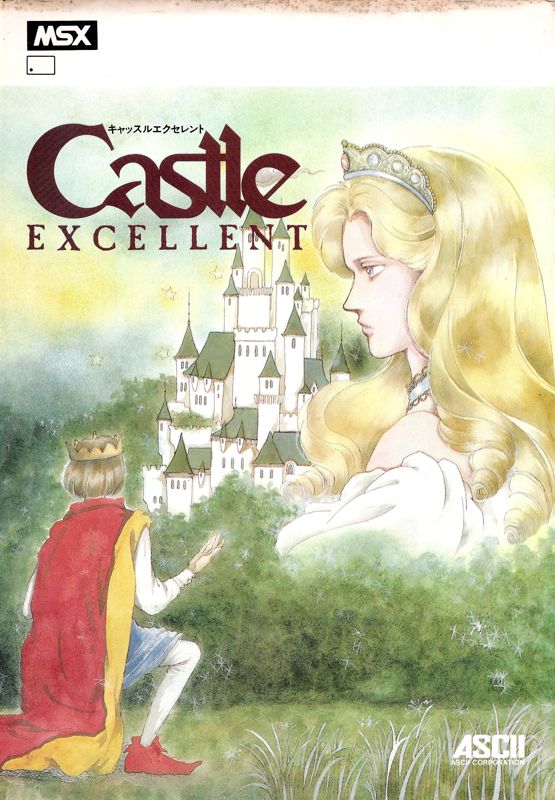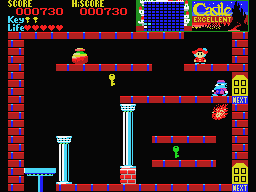Retro Replay Review
Gameplay
Castlequest plunges players into a sprawling labyrinth of 100 intricately designed rooms, each serving as a self-contained puzzle within a larger narrative. As the prince, your goal is simple in theory—save the princess—but achieving that goal demands precise timing, careful observation, and clever use of the items you uncover. Keys of varying colors unlock specific doors, while rings, gold bars, and other treasures pepper the rooms, often placed in clever locations that require acrobatic jumps or strategic baiting of enemy movements.
(HEY YOU!! We hope you enjoy! We try not to run ads. So basically, this is a very expensive hobby running this site. Please consider joining us for updates, forums, and more. Network w/ us to make some cash or friends while retro gaming, and you can win some free retro games for posting. Okay, carry on 👍)
The core platforming mechanics remain faithful to the original Castle, yet the expanded room layouts and fresh hazards elevate the challenge significantly. Enemy knights patrol predictable paths, but other threats—such as the lumbering Tiroler men—move in unexpected patterns that force you to adapt quickly. Environmental dangers like spiked floors, rolling boulders, and disappearing platforms keep tension high, turning every doorway into a potential triumph or setback.
Progression hinges on exploration and trial-and-error learning. At first, you may find yourself struggling to recall which key opens which door, or misjudging a leap over a knight’s lance. Over time, patterns emerge and shortcuts reveal themselves, rewarding those who pay attention to subtle visual cues. The balance between frustration and satisfaction is finely tuned: each victory feels earned, and each failure is a lesson in mastering the castle’s secrets.
Graphics
Visually, Castlequest leans into the charm of its 8-bit heritage, presenting crisp tile-based graphics with a surprisingly rich color palette. The stone walls, medieval banners, and shadowy chambers evoke a genuine sense of exploring a dilapidated fortress. Sprites for the prince, princess, and various enemies are simple yet expressive, with just enough animation frames to convey movement and personality.
Room designs showcase clever artistry: contrasting hues delineate safe zones from hazards, while background details—stained glass windows, flickering torches, and distant castle parapets—add depth to otherwise static screens. The key-and-door color system is visually intuitive, helping players quickly identify which areas they can access and which remain locked behind future discoveries.
While modern gamers may find the graphics rudimentary compared to contemporary titles, there’s a nostalgic appeal in the minimalist presentation. The absence of excessive visual flair keeps the focus squarely on puzzle-solving and platforming precision. In that sense, the aesthetic is a feature, not a limitation, reinforcing the game’s identity as a pure, challenge-driven experience.
Story
At its heart, Castlequest offers a classic damsel-in-distress tale: the princess has been kidnapped once more, and it’s up to the valiant prince to navigate the treacherous halls of Castle Excellent. There’s little in the way of cutscenes or dialogue, but the narrative framework provides enough context to motivate your quest. Every locked door and hidden passage carries the promise of inching closer to the princess’s chamber.
The sparse storytelling extends to in-game text: brief room descriptions and occasional status messages remind you of the stakes without interrupting the flow of exploration. This minimalist approach may feel bare-bones to those who crave rich lore or character development, but it serves the gameplay by keeping distractions at bay. Your imagination fills in the gaps, picturing sinister castle lords and the grateful smile of a rescued princess.
Ultimately, the story functions as a driving force rather than a focal point. It’s a timeless trope—rescue the captive—but one that resonates when paired with inventive puzzles and ever-escalating challenges. The sense of purpose it imparts makes each new key found and door unlocked feel like a step closer to a triumphant reunion.
Overall Experience
Castlequest is a masterclass in efficient game design, delivering 100 rooms of progressively demanding puzzles without unnecessary bloat. Whether you’re a veteran of the original Castle or a newcomer to retro platformers, you’ll find satisfaction in the game’s measured difficulty curve. Each room is a compact test of skill—and the sheer variety of obstacles ensures the action never grows stale.
Replayability stems from the urge to shave seconds off your completion times or to collect every possible item in one seamless run. While there’s no in-game timer, the pursuit of mastery encourages repeated playthroughs. Mapping out the most efficient routes through the castle becomes a game within the game, fostering a deeper appreciation for the level design’s intricacy.
In a modern market crowded with high-budget blockbusters, Castlequest stands out as a reminder that compelling gameplay need not rely on cutting-edge graphics or sprawling open worlds. Its tight controls, memorable puzzles, and unpretentious presentation combine to create an experience that’s both challenging and rewarding. For fans of puzzle-platformers and retro gaming enthusiasts alike, Castlequest offers a castle-worth of thrills and satisfaction.
 Retro Replay Retro Replay gaming reviews, news, emulation, geek stuff and more!
Retro Replay Retro Replay gaming reviews, news, emulation, geek stuff and more!









Reviews
There are no reviews yet.